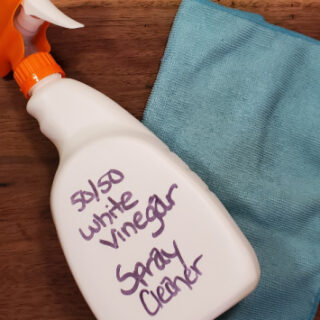Want the ultimate natural spring cleaning experience? Don’t turn up your nose–take another sniff of common, household white vinegar. For a green eco-friendly product for all your cleaning tasks, you cannot get anything better than vinegar.
Most kinds of vinegar are white, yellowish, shades of amber, red and almost black. For cleaning purposes, you will want to stick with plain old white vinegar.
Where Does White Vinegar Come From?
Vinegar can be derived from several sources – most common are fruit and grains, like apples and rice, but it’s even made from wood and roots.
You’re probably most familiar with kinds of vinegar made from fruit juice. The juice contains sugars that ferment into alcohol, changing the juice into wine. From there, the fermentation continues until the wine evolves to a new state–vinegar
What a surprise to the cook who stores a wine bottle under the kitchen counter then opens it to find the sweet wine has turned to vinegar.
That’s the natural process it takes – given the right conditions, the alcohol in the wine changes to vinegar – hence, the name, wine vinegar.
Benefits of Using White Vinegar to Tackle Your Toughest Cleaning Tasks
I use vinegar to clean with quite frequently. I have had asthma since childhood. Spraying aerosol sprays or strong-scented chemicals triggers the wheezing. While vinegar doesn’t have the added fragrance of some of those commercial cleansers, it also doesn’t have the chemicals.
The use of vinegar over commercially-made products also means that I’m not flushing harmful chemicals down my drains or exposing my little dog to the residue.
Plus, as you all know from my recent rant about why I hate the toxicity of dryer sheets, I am all about choosing eco-friendly products for cleaning.

How to Make White Vinegar Spray Cleaner
Skip the harsh chemicals you often find in all-purpose cleaners! Mix this white vinegar spray instead.
Materials
- Spray bottle (I removed the label from a past commercial product and recycled the bottle)
- Funnel
- 12 ounces of distilled water
- 12 ounces of white vinegar
Instructions
- Remove the lid from the spray bottle
- Pour in the twelve ounces (each) of white vinegar and distilled water. Use the funnel to prevent making a mess!
- Replace the spray lid and gently shake to mix the ingredients into a healthy all-purpose cleaner.
Notes
Shake gently during before and during every use
Why distilled water? It does leave limescale or rust marks. You may use tap water, if you wish.
7 Ways to Use White Vinegar for all Your Cleaning Tasks
Try this alternative to clean all these things…
1 – Kill Germs Everywhere
Vinegar Is a natural germ fighter. It’s proven to conquer gram-neutral strains of bacteria. These culprits include e. Coli and other bacteria. Use it to wipe down your kitchen after you’ve handled raw meats.
The germ-fighting properties of vinegar are legendary. However, it’s mildly acidic. This acidity means you should never use vinegar on granite, marble, or natural stone.
2 – Sparkling Glassware
No embarrassing spots on your glassware the next time you entertain friends!
In case your glassware has a soap film that leaves them cloudy, try soaking it in a solution made of a half cup of vinegar to a gallon of water. Leave it for a half-hour, then remove and rinse well.
Dry your glasses, and you’ll have a sparkling, spot-free shine.
3 – Clean and Deodorize the Toilet
Sanitize your toilet bowl, vanity top, and bathroom sink with vinegar.
You can clean and deodorize your toilet bowl by pouring one to two cups of undiluted white vinegar into the bowl. Allow to stand for a few minutes, then scrub and flush.
Fresh, sanitized, and no harmful toilet bowl cleanser down the drains.
4 – Kitchen Appliances
Spring cleaning kitchen appliances with vinegar will kill any germs accidentally spread to those appliances during cooking.
Vinegar will also remove greasy dirt and drops from your stove and refrigerator.
Simply moisten a paper town or household sponge with vinegar from the bottle, and wipe. Works on chrome and stainless steel, as well.
5 – Clean Your Bathtubs or Showers
Sparkling clean from the chrome fixtures to the tub floor. Love spring cleaning!
I love cleaning the bathtub and shower with vinegar. That is, provided your shower is made of porcelain tile, glass, fiberglass or other man-made materials. You can keep your shower stall clean and glowing by just giving it a gentle scrub down with white vinegar to cut through built-up soap residue.
To maintain that cleanliness in your shower, consider a change in bath soap. Natural Castile soaps, such as coconut Castile, are made from vegetable oils as opposed to waxes. Natural oils are easier to dissolve and rinse away.
6 – Coffee Pot
Freshen your electric coffeepot and remove coffee stains from the glass pot by filling the water container with vinegar and running it through a cycle. Rinse three or four times with fresh water.
This practice also helps to extend the life of your coffeemaker.
7 – Fight Fleas
Protect your pets and home from invasions of fleas with white vinegar during your deep clean.
Got pets? Wash their bedding in hot water and one cup of white vinegar. Fleas cannot stand the smell of vinegar. So, while the hot water wash sends the fleas down the drain, the residual aroma will repel new infestations.
Vinegar is also considered safe as a rinse after you bathe your pet–be sure not to get it into their ears or eyes, though.
The Takeaway: Housecleaning with Confidence
You can tackle those much-hated (but oh so necessary) spring cleaning tasks with confidence when you choose to clean with white vinegar. You’ll refresh your home knowing that you are keeping your family, pets, and the environment a safer place.

